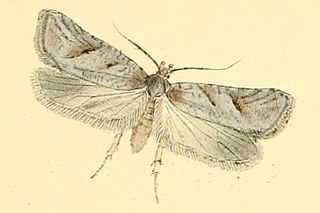This list contains species first discovered in Hong Kong, with the endemic species asterisked.

Aroga is a genus of moths in the family Gelechiidae.

Deltophora is a genus of moths in the family Gelechiidae. The genus was originally described from South Africa and based on a taxonomic revision contains about 20 species on all continents except Antarctica. Host plants of larvae and adults are only known for two Chinese species of Deltophora.
Issikiopteryx is a genus of moths in the family Lecithoceridae.

Eristena is a genus of moths of the family Crambidae.

Macrobathra is a genus of moths in the family Cosmopterigidae. Most species are endemic to Australia.
Meleonoma is a genus of moths in the family Autostichidae.

Depressaria is a moth genus of the superfamily Gelechioidea. It is the type genus of subfamily Depressariinae, which is often – particularly in older treatments – considered a distinct family Depressariidae or included in the Elachistidae, but actually seems to belong in the Oecophoridae.

Epicephala is a genus of moths in the family Gracillariidae.
Cosmoclostis gmelina is a moth of the family Pterophoridae. It is found in Hainan, China.

Agonopterix is a moth genus of the superfamily Gelechioidea. It is placed in the family Depressariidae, which was often – particularly in older treatments – considered a subfamily of the Oecophoridae or included in the Elachistidae.

Autosticha is a genus of gelechioid moths. It belongs to the subfamily Autostichinae, which is either placed in the concealer moth family (Oecophoridae), or in an expanded Autostichidae. It is the type genus of its subfamily. Originally, this genus was named Automola, but this name properly refers to a fly genus in family Richardiidae.

Exaeretia is a moth genus of the superfamily Gelechioidea. It is placed in the family Depressariidae, which is often – particularly in older treatments – considered a subfamily of Oecophoridae or included in the Elachistidae.
Anabasis zhengi is a species of snout moth. It was described by L.X. Li and H.H. Li in 2011. It is found in China (Yunnan).
Acria is a moth genus of the superfamily Gelechioidea. It is placed in the family Depressariidae, which is often – particularly in older treatments – considered a subfamily of Oecophoridae or included in the Elachistidae.
Acria nivalis is a moth in the family Depressariidae. It was described by Wang and Li in 2000. It is found in China (Henan).
Autosticha cipingensis is a moth in the family Autostichidae. It was described by S.X. Wang in 2004. It is found in China (Jiangxi).
Autosticha complexivalvula is a moth in the family Autostichidae. It was described by S.X. Wang in 2004. It is found in China (Gansu).
Autosticha nanchangensis is a moth in the family Autostichidae. It was described by S.X. Wang in 2004. It is found in China (Jiangxi).
Autosticha valvidentata is a moth in the family Autostichidae. It was described by S.X. Wang in 2004. It is found in China (Fujian).









